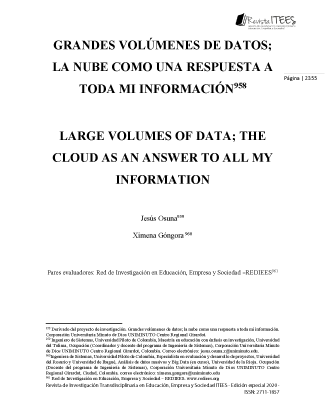CXXIV. LARGE VOLUMES OF DATA; THE CLOUD AS AN ANSWER TO ALL MY INFORMATION
##plugins.themes.bootstrap3.article.main##
Abstract
This article aims to cover the meaning of Big Data, based on the interest of human beings
and a consumer society that has always asked for more, with the aim of keeping the world
interconnected. In this sense, it becomes relevant that the world has had to go through a series
of technological innovations; as was the use of punch cards with small holes that stored
information (data), in the 60s, giving way to magnetic tapes that allowed to store up to 10
thousand times more information than what was already had. However, and as is known,
today we live in a consumer society that over the years has begun to produce and consume
more than it has already had, causing data storage to begin to be limited and short , for the
need that was being presented; That is why this article aims to show how the cloud can be
understood as a means that allows users to access programs, data and others through the
Internet, in such a way that the information can be synchronized through the web, all through
a documentary review methodology that reflects that what is being proposed is true today,
taking into account that today there are more than 52 billion connected electronic devices
that provide greater consumerism and greater production of new data.
Download Statistics
##plugins.themes.bootstrap3.article.details##
big data, information, document review, cloud.
análisis de protocolos para varias nubes. Puente, 9(2), 33-40.
Bravo, L. J. (2015). Análisis del modelo de negocio del cloud computing. Caso: empresa de
desarrollo DevTeam (Master's thesis, Universidad Andina Simón Bolívar, Sede
Ecuador).
Data, B., & La, E. N. (2016). Big data. Pobrano z: http://www. gartner. com/it-glossary/bigdata.
Del Vecchio, J. F., Paternina, F. J., & Miranda, C. H. (2015). La computación en la nube: un
modelo para el desarrollo de las empresas. Prospectiva, 13(2), 81-87.
Gómez, L. (2010). Un espacio para la investigación documental. Revista Vanguardia
Psicológica Clínica Teórica y Práctica, 1(2), 226-233.
Hernández, N. L., & Florez-Fuentes, A. S. (2014). Computación en la nube. Mundo Fesc,
4(8), 46-51.
Joyanes, L. (2013). Big Data: análisis de grandes volúmenes de datos en organizaciones.
Editorial Alfaomega.
López García, D. (2013). Análisis de las posibilidades de uso de Big Data en las
organizaciones (Master's thesis).
Morales, O. (2003). Fundamentos de la investigación documental y la monografía. Manual
para la elaboración y presentación de la monografía. Mérida, Venezuela: Universidad
de Los Andes.
Ortiz Morales, M. D., Aguilar, L. J., & Giraldo Marín, L. M. (2016). Los desafíos del
marketing en la era del big data. E-Ciencias de la Información, 6(1), 16-45.
Panchana-Flores, J. E. (2017). Estudio teórico conceptual sobre la computación en la nube
móvil. Dominio de las Ciencias, 3(3 mon), 126-136.
Rueda, F. (2009). ¿Qué es la computación en la nube? Revista Sistemas, nro, 112, 72-80





